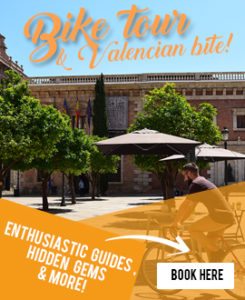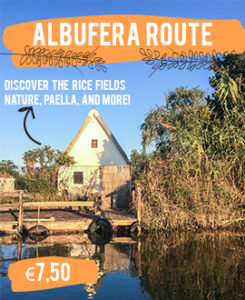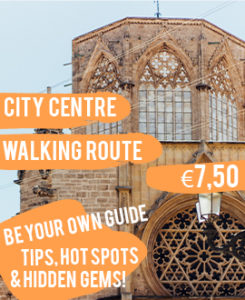Valencia has plenty of attractions and sights, so make sure you don’t miss out on the beautiful and historical sights the city has to offer and the impressive modern architecture complex “City of Arts and Sciences”, when doing some sightseeing! If you are just staying in Valencia for a couple of days, this list is perfect.
America’s Cup
The unique design of the Veles e Vents building which is surrounded by the sea and the harbour make the America’s Cup a must see when you are visiting Valencia. For the sport enthusiasts it might be even more special because of the sailing history the America’s Cup has. You can enjoy the sun with a drink and some dancing or experience a luxurious night out at La Sucursal. For more information go to America’s Cup.
Cathedral
One of the highlights of Valencia is the Cathedral, built in 1238. The cathedral is centrally located on the Plaza de la Reina and has three entrances. Left of the main entrance is the bell-tower of the cathedral, el Micalet. Built in 1381, el Micalet is the highest religious structure in Valencia. Climb the stair to the top for a spectacular view! For more information go to Cathedral.
La Nau
When you are looking for a beautiful building with a lot of history in the city centre of Valencia, La Nau is a place you should visit. This former university has changed into a cultural centre, but the traditional style is still like it used to be. Readings, debates, courses and more cultural activities are being organized here nowadays. For more information go to La Nau.
Lonja de la Seda
Absolutely worth visiting is the Lonja de la Seda attraction, the old silk market. The building built in Gothic dates back to 1483 and is listed on the World Inheritance List of UNESCO. Nowadays the Lonja de la Seda is used for expositions, but the beautiful monument is open to visitors. For more information go to Lonja de la Seda.
Mercado de Colon
The beautiful Mercado de Colón, or Columbus Market, is designed by architect Francisco de Mora y Berenguer and constructed between 1914 and 1916. It was completely renovated in 2003 which costed about 33 million euros. The market is located in neighbourhood L’Eixample, between Calle Colón and Gran Vía Marqués de Turia and includes shops, bars, cafés, restaurants and underground parking. For more information go to Mercado de Colón.
Santa Catalina
Close to the cathedral of Valencia is the “Iglesia de Santa Catalina”, the church of Santa Catalina. The Gothic church acquired the rank of parish in the thirteenth century. Its bell tower wasn’t built between 1688 and 1705 and is considered El Micalet’s “wife” (the cathedral’s bell tower). For more information go to Santa Catalina.
Torres de Serranos
Valencia used to be surrounded by a city wall and to only way to enter the city was to go through one of the twelve city gates. The Torres de Serranos was one of these twelve city gates built in the 14th century, which remained intact for a different purpose later on. Between 1586 and 1887 the tower was used as a prison and in 1936 (during the civil war) as a storage room for 525 paintings from the Museo del Prado in Madrid. Climb this attraction, Torres de Serranos, for only €2,00 and you will have an amazing view over the city. For more information go to Torres de Serranos.
Estación del Norte
The modernistic “Estación del Norte, or train station, was opened in the year 1917. This train station is designed by Demetrio Ribes. It contains various Valencian mosaics on the facade of the building. Inside the train station next to the entrance doors, you will find the words ‘pleasant journey’ in different languages (in mosaic). For more information go to Train station.
Palacio de Correos y Telégrafos
On Plaza del Ayuntamiento, or the Municipal Square, you will find the main post office of Valencia called “Palacio de Correos y Telégrafos”. The building of the post office is designed by Miguel Ángel Navarro in 1914, however not built untill 1922. Make sure you take a look inside this impressive building! For more information go to Post office.
City of Arts and Sciences
The “Ciudad de las Artes y Ciencias”, or in English City of Arts and Sciences, is a complex designed by Santiago Calatrava and Félix Candela. It exists of six artistic buildings/projects: L’Umbracle, Palau de les Arts, L’Oceanogràfic, L’Hemisfèric, Museo de las Ciencias and Agora. The City of Arts and Sciences is situated at the end of the former riverbed of the river Turia, which was drained and rerouted after a catastrophic flood in 1957. The Turia is now a beautiful sunken park. For more information go to City of Arts and Sciences.
Turia Park
El Jardín del Turia, or the Turia park is a verdant sunken park that used to be a riverbed. After a catastrophic flood in 1957 which devastated the city of Valencia, the government decided to divert the course of the river and to create a park on the fertile soil of the old riverbed. The park extends over approximately 9 kilometers and is home to several cultural projects; the City of Arts and Sciences, the Palau de la Musica and a space between the bridges ‘Puente de las Flores’ and ‘Puente de la Exposición’ that is used for different events all year round. Furthermore, the park is full of trees, plants, flowers, fountains, playgrounds and other facilities and the bridges still cross the river, so you won’t find any cars disturbing the peace.





